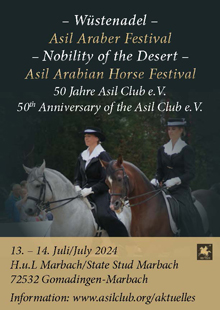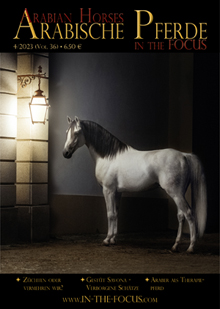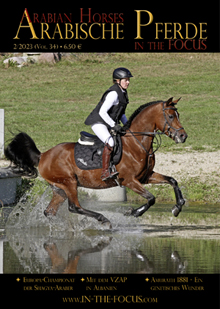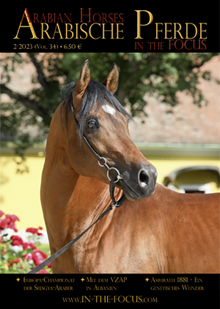One name pops up again and again, when it comes to the foundation horses of European Arabian horse breeding: Baron von Fechtig. But he did not only import horses, he maintained a stud over many years, where he bred “pure Arabian horses”. Unfortunately, hardly any horse of his breeding can be found in the pedigrees of today’s horses – except in Haflinger horses!
Of his imports, Baron von Fechtig kept some of the horses for breeding. However, he had to realize that his property at Kirchschlag was not suitable for Arabian horse breeding due to the hilly pasture and the wet climate, and it also became quite quickly too small. So, he decided to move his stud in 1825/26 to Lengyeltóti, about 12 km South of Fonyód at the lake of Balaton. Here, Baron von Fechtig leased a property from Count Anton von Inkey with huge pastures and soon after, his stud became bigger and bigger. It consisted of three parts, of the Arabian Stud, including the original imports and their purebred offspring, of the Hungarian riding horses and of carriage horses.
The Arabian stud consisted of 15 original Arabian (i.e. desertbred) mares and their purebred offspring by original Arabian stallions. Within just a couple of years the numbers rose to 70 to 80 horses, including the youngstock.
Of the year 1826-27, we have a report of the following stock list: four original Arabian stallions: El Bedavi, Hadban, Cohesuan, Obeyan; four self-bred stallions of original heritage: Samhan, Marssaud, Chebessian, Saklavy; 16 original Arabian mares: Fidavie, Zohée, Monakye, Harsa, Abeye, Saklavy, Melhaye, Obaye, Warde, Bedue, Koheyle, Wadue, Habibe, Hlatie, Hamdanie and six self-bred mares: Saklavy, Gidran, Monakye, Warde, Kohie, Zohée. Apart from these 29 horses known by name, there were about another 50 foals of all ages at the stud.
Foundation stallion El Bedavi
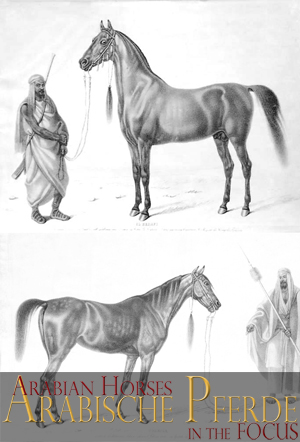
El Bedavi and Coheile, two Original Arabs owned by Baron von Fechtig
Especially the stallion El Bedavi db was the pride of his owner and was praised by the experts: El-Bedavi db, gold brown, strain Koheyl without any markings, 15 fist 1 inch – he was imported with the last transport of Fechtig in 1825 and came as a three-year-old into the stud. Hörmann described him as follows: “In this beautiful animal one can see all signs of his noble heritage combined. He is quite tall and is of excellent conformation with rare harmony in all parts. The play of colours in his silk-like coat shows all variations from brown to red, and depending on his position to the light it may appear bay; the very straight head, wide between the eyes, is well set on the neck, so that the groove between the processes of the first cervical vertebrae and the ossa temporis, down to the larynx is clearly visible; the beautiful, well opened ear and the lively eye clearly show the perfection of these two senses; the nostrils are wide open. The long neck, which is in good proportion to the other parts of the body, shows a deep depression before it passes into the sharply defined withers. The back, the loins and the almost horizontal and wide croup do not leave any wishes open with regards to their coupling and formation; the croup especially satisfies with its unusual strength, at least for an oriental horse.
The individual parts of his legs are in ideal proportion to each other, with an excellent angle of the shoulder. His movements correspond with the correct construction of his legs, due to his spirit, he gains the strength and stamina which one can only find with the noble Arabian – and with some exception in the English Thoroughbred – and which proves his pure Oriental heritage.” While at the same time von Biel wrote about him: “[He is] the most practical of all Arabian stallions, that I have ever seen. Wonderful breast, well balanced and just excellent below the knees.”
His 12 foals, born in 1828, were according to Hörmann “of excellent beauty and strength; he also proves the heritage of his nobility by his unique head, which he gives on to his children.”
Reducing the Numbers
The stud grew in the following years quickly, so that Baron von Fechtig, in 1833, had to reduce the numbers. On 10th June 1833, the announcement of “liquidation” of the stud of Baron von Fechtig was published in the press: “Not long ago, the big and excellent stud of Baron von Fechtig at the Hungarian village of Lengyeltóti was sold. The auction went on for three days, and horse lovers from almost all European countries were present. Among them you could see Count Hardegg, General Inspector of the Imperial Austrian Studs; Mr. von Coetdihuel, Supervisor of the French Studs, as well as many German and English equerries. Among the many excellent horses, the buyers were especially fighting over the purchase of El Bedavi.”

More than 50 horses of the stud of Baron von Fechtig were for sale in 1833.
Also, at the Royal Stud of Weil (Kingdom of Württemberg) there was interest in this auction, and Julius von Hügel, who happened to be in Vienna at the time, was sent to Hungary to buy a certain horse. To do so, he was given 800 Ducates, plus 500 Gulden for his travel expenses and the transport of the horse. It is not quite certain from the old documents, which horse he was meant to buy, but it might be safe to assume, that it was indeed the stallion El Bedavi, because in the end, von Hügel was not able to buy the horse, as somebody else had offered more. It says in the records: “Much to the annoyance of the Hungarian nobility the horse [El Bedavi] was finally bought by Mr. Coetdihuel for the French government. This horse is of bay colour, just like most of his offspring. Most of his male offspring are sires in Hungarian and German studs. It may serve as proof of the value the Hungarians have placed upon El-Bedavi, the father of all these noble animals, that Mr. Coetdihuel could take him – as well as the stallion Vadne and five very beautiful mares – only under the protection of some Husars, because the inhabitants of the surrounding area tried prevent him leaving the country.
The French General-Agent of all Studs, Baron Coetdihuel bought five mares, of which the two best together with their foals cost some 1068 Ducats, and for the stallion El Bedavi he paid 1200 Ducats, although he was no longer young.”
Apart from El Bedavi db, his son Vadne (out of El Bedue db), chestnut, born 1829, and the mares Fedawie db, grey, born 1822; Warda db, bay, born 1821; Hamdanie (El Bedavi db / db mare), bay, born 1826; Koheyl db., grey, born 1820 and Monaghie, grey born 1822 were exported – the last three mares were all covered by El Bedavi.
Skeptical French
Back home, the French were very critical about the Arabian horses from Hungary, especially about the stallion El Bedavi db, and they asked, if such a high price was justified, as the horses were meant to improve the existing breed. They had already heard of the excellent reputation of this stallion, but in their opinion he did not justify it. “However, he does not deserve the contempt brought against him by the lovers [of English Thoroughbreds] in Paris and by most of the breeders in Limousin”, Comte Achille de Mentendre wrote, but he also asked what they had achieved in breeding since they arrived. “Where are the products of these stallions and mares, which are worth mentioning?” Especially as the stallion as well as the mares were regarded as the best specimens of the stud of Baron von Fechtig. And so the question was raised, why he actually sold them? “I have reached a point”, Baron von Fechtig answered, “where I could part with El Bedavi and some of my mares, without endangering the existence of my stud, even though they belong to the best of my breeding. The reason is simple, I have offspring of them, which can replace them perfectly.” And indeed, Baron von Fechtig retained 18 offspring of El Bedavi from his Arabian mares. After the auction, in October 1833, the stud still had 80 purebred and 120 halfbred mares, together 200 heads. Obviously, Baron von Fechtig had to reduce the number of horses even more, as the property at Lengyeltóti would feed only a limited number of animals.
When Anton von Inkey terminated the leasing contract for Lengyeltóti in 1840, Baron von Fechtig had to move his stud to Transylvania, where he bought the domain Bulcs. With this move, he was rather far away from any potential buyers and things became quiet.
In spring 1844, the Royal Stud of Weil again got in contact with Baron von Fechtig to buy a stallion. Equerry von Hügel was sent to Vienna, where he was supposed to see him. Von Hügel bought a stallion named El Bedavi and in the records it says: “On 3rd May 1844 came the stallion Nr. 272 – El Bedavi from Vienna to the Royal Stables (in Stuttgart). Bay, with few white hair on the forehead, a snip, both right pasterns white, stallion, 5 years old and 15 fist 2 inches high. Remark: Has a windgall on his left frontleg. Descent of the stallion El Bedavi, born in the stud of Baron Fechtig at Bultsch in Hungary out of the Arabian mare Bedue and the stallion Hlavie, son of El Bedavi.” Hence, he was a grandson of El Bedavi db who they couldn’t buy in 1833. However, the stallion remained in the Royal Stables and was not used for breeding in Weil.
Baron von Fechtig died ca. 1850 in Temeswar and the stud was dissolved.
Haflinger Breed
The stallion El Bedavi (in France “Elbedavy”), whom the French regarded so sceptically, stood at stud in Pompadour from 1834-35 and in Tarbes from 1836-37. Indeed, he was hardly used, and there are no (!) purebred Arabian offspring recorded in the French studbook, except for those which were imported from Hungary.
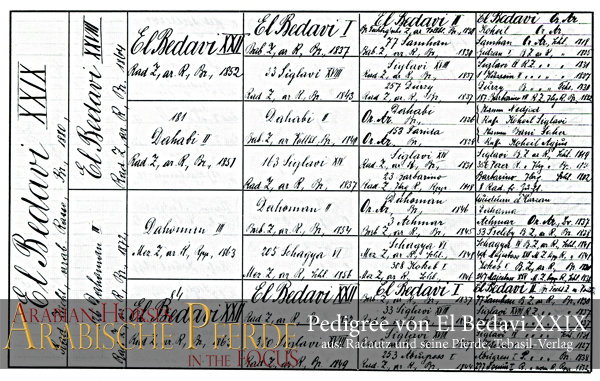
Although the horses that Baron von Fechtig imported from the Orient, became foundation stock in various European countries, the horses of his own breeding were by far less successful. The most important may have been El Bedavi II (El Bedavi db / Koheil db) *1830, who was used at Bábolna in Araberrasse (later called Shagya Arabian) breeding. His great-grandson, the stallion 133 El Bedavi XXII (out of 361 Dahabi-4) was the founder of a sire line in Haflinger breeding, but he came closer to his Gidran ancestors of his dam. The El Bedavi stallion line was soon given up in Bábolna and Radautz and died out at the end of the 19th century.
Gudrun Waiditschka








